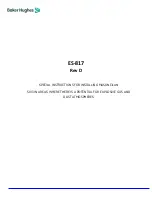
20-02245 REV E
II
APPLICATION NOTE
INTERCONNECTING RS-485 CONTROLLED COMPONENTS
1.
INTRODUCTION
ROS has introduced versions of our most popular underwater products that are
controlled via RS-485 serial communication. This application note describes our
recommendations to produce the best results when interconnecting products that share
the same power and serial data communication lines.
2.
OBJECTIVE
The objective of this application note is to guide the system designer so that he
or she obtains the best results when networking any of the ROS products listed in
section 3. When networking video devices, the system designer must consider their
sensitivity to electrical noise. Products such as the SmartLight can produce small levels
of electrical noise that is exacerbated over long cable lengths.
3.
LIST OF ROS UNDERWATER RS-485 PRODUCTS
.
To satisfy customer needs, ROS has developed turn-key net workable
underwater products. Each of the products listed below has an integral RS-485
electronic driver. One of the main advantages of RS-485 serial communication is the
ability and ease of networking of several products over a bus line.
RS-485 CE-X-18:1, miniature color zoom camera
RS-485 INSPECTOR, color zoom camera
RS-485 PT-10, pan & tilt
RS-485 PT-25, pan & tilt
RS-485 Atlas high torque pan & tilt
RS-485 SmartLight, high intensity LED lamp
4.
RS-485 NETWORK
RS-485 is currently a widely used communication interface for data acquisition
and control applications where multiple nodes intercommunicate. In other words,
multiple RS-485 loads/nodes can be interconnected via a single serial communication
bus line. ROS has adopted RS-485 half duplex, 8-bit data, one stop bit, no parity, no
hardware flow control, and 9.6/19.2/57.6 kbps as standards.























